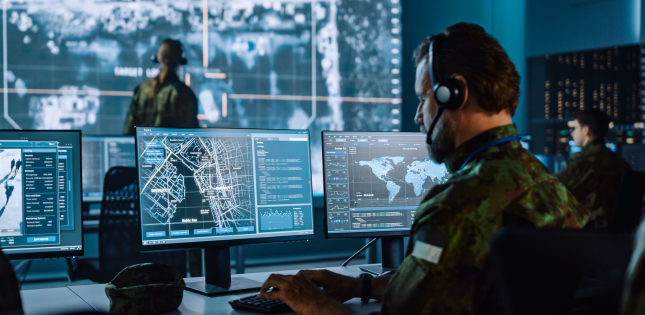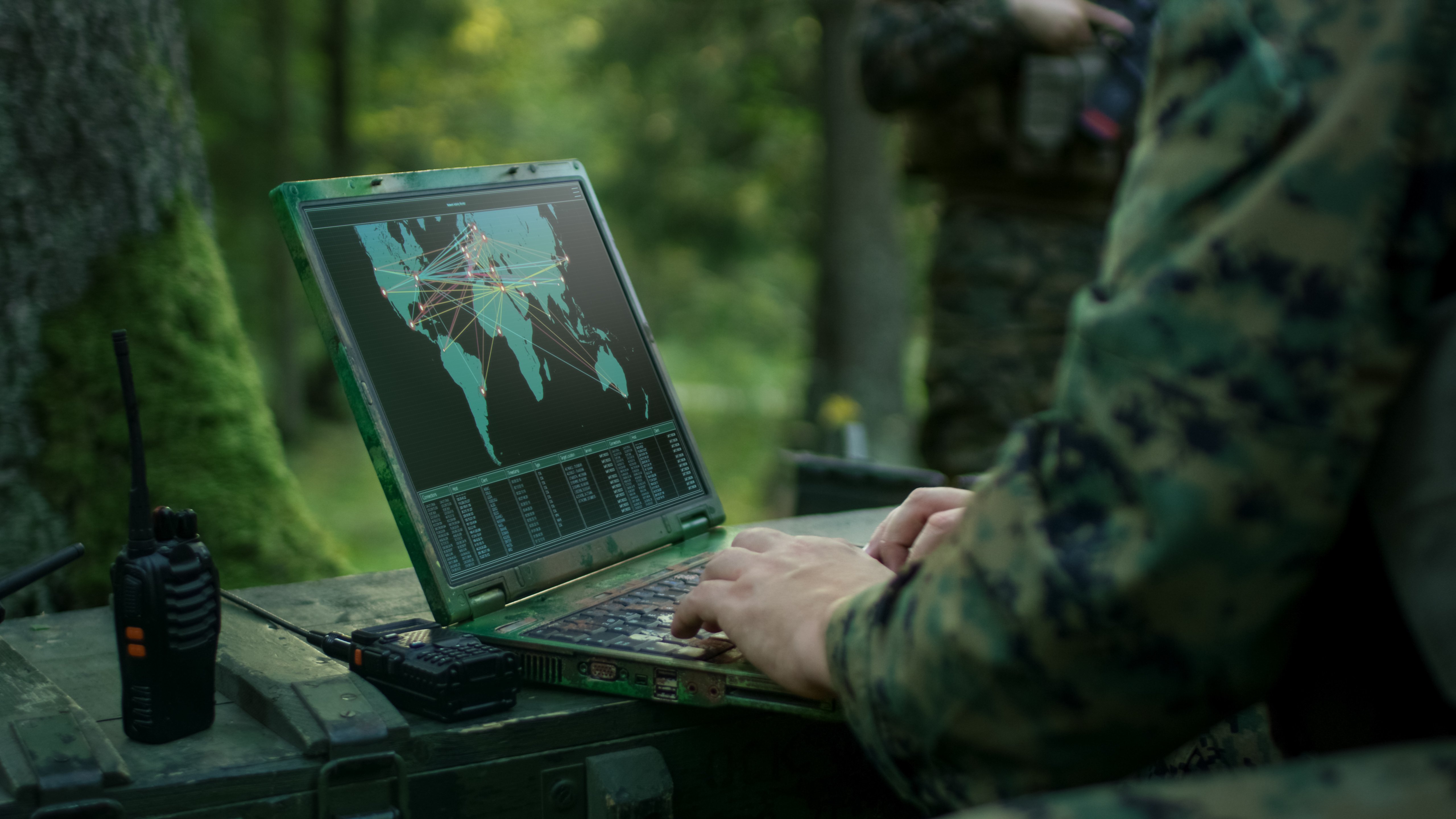5 min read
Enter JADC2: Real-Time Decision-Making at the Speed of Relevance
 Chip Downing
:
June 15, 2023
Chip Downing
:
June 15, 2023

Part 1 of the JADC2 Blog Series
Rapid changes in the global security environment are challenging the U.S. Military’s ability to seize, maintain and protect its information and decision advantage over potential adversaries. These challenges require a focused U.S. Department of Defense (DoD) effort to modernize how the Joint Force develops, implements and manages its Command and Control (C2) capabilities to prevail in all operational domains, across echelons, and with coalition mission partners.
Enter JADC2
To address this challenge, the U.S. Department of Defense (DoD) created the Joint All-Domain Command and Control (JADC2) initiative to revitalize the military’s current command and control (C2) infrastructure. JADC2 aims to establish a combined, synergistic network of sensors and warfighters that enables collective, real-time decision-making across the Air Force, Army, Marine Corps, Navy, Cyber and Space Force, across all warfighting domains.
This integrated network will provide the sensor and target data from the tactical edge to C2 systems, coupled with weapons and effectors resources to select the optimal response within hours, minutes, or potentially seconds. This acceleration is significant, compared to the current multi-day process needed to analyze the operating environment and issue commands.
JADC2 will enable the Joint Force to share intelligence, surveillance and reconnaissance data in real-time. JADC2 will make it possible to transmit across diverse network domains to enable faster decision-making using artificial intelligence algorithms that can identify targets, then recommend the optimal weapon—both kinetic and non-kinetic—to engage the target.
JADC2 Participants
JADC2 is not a single entity or service or program. JADC2 provides an integrated approach for shaping future Joint Force C2 capabilities and is intended to produce the warfighting capability to sense, make sense, and act at all levels and phases of war, across all domains, and with designated partners, to deliver a decisive information advantage to the operational and tactical commander so they can converge joint and multi-domain effects at the speed of relevance.
It is a combined strategy with our coalition partners based upon the democratization of data through all echelons that creates a posture of deterrence against all adversaries, where soldiers outside of the command center will have the same data as the leaders inside the command center. This pan-echelon data strategy enables a mission command that endures attacks against the command chain.

In terms of scope, JADC2 is not just for linking military platforms only – it also applies to all entities underpinning a country’s existence, including food/fisheries/grain, global supply chains, energy/oil/gas, and even environmental challenges like climate change. JADC2 integrates our global partners across the commercial and military domains to create a permanence of lethality, similar to the Nuclear Triad, that creates a forward-leaning posture of deterrence against all adversarial actions that threaten the peaceful existence of a country’s enterprise.
Full deployment of JADC2 will result in an open system architecture that will enable faster and more resilient communications from the tactical edge to the cloud. JADC2 links fused sensor and reporting data to the best shooter/effector that spans and flattens traditional organizational hierarchies.
General Mark Milley, Chairman of the Joint Chiefs of Staff, captures the essence of JADC2 with his statement: “We don’t fight wars as an Army, a Navy...we fight wars as a nation...we fight wars with allies and partners.”
How Do We Build JADC2?
The JADC2 problem space is complex and is hampered by the current patchwork of brittle, stove–piped legacy systems, equipment, bespoke networks that support singular security domains, and a variety of data configurations with hard–coded, proprietary interfaces and structures that require data unpacking, translation and repackaging at the tactical edge. This approach incurs significant overhead that throttles real–time networks and impedes the speed of convergence — at a time when real–time information delivery is paramount and can mean the difference between success or failure.
To drive increasing competitiveness, the DoD has adopted a Data Strategy that states, “The DoD is a data-centric organization that uses data at speed and scale for operational advantage and increased efficiency.” Furthermore, it mandates that, “It is the responsibility of all DoD leaders to treat data as a weapon system and manage, secure, and use data for operational effect.”¹ This document outlines seven goals of this strategy — to make data Visible, Accessible, Understandable, Linked, Trustworthy, Interoperable and Secure (VAULTIS) that defines the future foundation of JADC2 connectivity.
The U.S. Air Force, U.S. Army and U.S. Navy are already building out JADC2 systems, and have created three projects -- the Advanced Battle Management System (ABMS) project, Project Convergence and Project Overmatch, respectively, to address these network and interoperability needs. In addition, the DOD JADC2 Cross-Functional Team (CFT) is driving multi-pronged efforts across data standardization, optimized human responses with AI/ML, resilient transport layers, mission partner data sharing, and more. Furthermore DARPA is refining Mosaic Warfare concepts that will transfer raw intel into aimpoints. The implementation of these systems is now driving the emergence of data requirements that will guide and refine successful implementations of JADC2.
What is JADC2?
JADC2 capabilities can be defined using the table below:
| JADC2 Capability |
JADC2 |
Not JADC2 |
| Posture |
Always-on, Forward Leading |
Reactive, Response-Driven |
| Participants / Parallelism |
All Joint Force members, including regional and coalition partners, across all warfighting domains |
Singular responses by individual armed forces and agencies, including regional partners as required |
| Data Sharing |
Real-Time sharing of relevant intelligence with all JADC2 participants |
Sharing of data as controlled by human-based declassification procedures |
| Decision / Response Time |
Seconds to Minutes |
Hours to Days to Weeks |
| Decision Process |
Sense, Make Sense, Act process with AI augmentation (Human on the loop) |
Observe, Orient, Decide, Act (OODA Loop) process (Human in the loop) |
| Use of AI and ML |
Core JADC2 design requirement for accelerated decision-making |
Investigative and experimental use only |
| Design Centricity |
Data Centricity Required |
Network-Centric, Message-Centric |
| Network Dependencies |
Network Transport Agnostic, ready to expand and include new capabilities / partners as required |
Network Sensitive / Dependent, brittle updates and integration |
| Multi-Level Security Support |
Shared Network Resources across all operational domains |
Dedicated, domain-specific single-level security (SLS) network resources |
| Zero Trust Security |
Yes, Mandatory |
Network- and Supplier-Dependent |
| Modular Open Systems Approach (MOSA) Support |
Must be MOSA by Design |
Supplier / Agency / Domain Proprietary |
| Standards |
Must Supports Open Standards, MOSA |
Proprietary / Limited Standards |
| Cloud to Tactical Edge |
Required Connectivity |
Dependent upon Network Supplier |
| Disconnected Operations |
Support for Disconnected, Intermittent, and Lossy (DIL) Networks |
Cannot Support or Highly Sensitive to DIL network operations |
| Interoperability |
Must be Interoperable with other systems using Open Standards |
Proprietary Interoperability capabilities |
| Scalability |
Must rapidly scale without interruption to mission from to prototype to deployed missions (100x) without interruption |
Increasing scale requires frequent system shutdowns / restarts and reconfiguration leaving sensing unaware and assets disabled |
| Network Monitoring |
Resilient Cloud to Tactical Edge network operations intelligence required |
Enterprise and/or Supplier-specific tools and services |
“The costs of not implementing this strategy are clear. Failure to meet our defense objectives will result in decreasing U.S. global influence, eroding cohesion among allies and partners, and reduced access to markets that will contribute to a decline in our prosperity and standard of living.” – 2018 National Defense Strategy
Data Will Drive JADC2 Success
Live, relevant real-time data will drive JADC2 systems, and there are now well-defined data requirements that will form the backbone of all C2 decisions. These requirements span and include having data centric architectures, networks that use multiple transports, creating a need for solutions that are transport agnostic, have multi-domain security enclaves, employ zero-trust systems, provide global interoperability, have connectivity from the tactical edge to combat clouds, and more.
RTI ConnextⓇ, now deployed in over 1,500 defense systems and over 70 command and control (C2) platforms, is the trusted connectivity framework for JADC2. Stay tuned to this blog series to learn more about JADC2 requirements, and hear from distinguished leaders from around the globe on the challenges and successes of building and deploying JADC2 systems.
About the author

Chip Downing is Senior Market Development Director, Aerospace & Defense, Real-Time Innovations, Inc.
Chair, FACE Business Working Group Outreach Subcommittee
Posts by Tag
- Developers/Engineer (180)
- Technology (79)
- Connext Suite (77)
- News & Events (75)
- 2020 (54)
- Standards & Consortia (51)
- Aerospace & Defense (50)
- Automotive (38)
- 2023 (34)
- 2022 (29)
- IIoT (27)
- Leadership (24)
- 2025 (23)
- Healthcare (23)
- 2024 (22)
- Connectivity Technology (21)
- Cybersecurity (20)
- 2021 (18)
- Culture & Careers (15)
- Military Avionics (15)
- FACE (13)
- Connext Pro (10)
- JADC2 (10)
- ROS 2 (10)
- Connext Tools (7)
- Connext Micro (6)
- Databus (6)
- Transportation (5)
- Case + Code (4)
- Connext (4)
- Connext Cert (4)
- Energy Systems (4)
- FACE Technical Standard (4)
- AI (3)
- Oil & Gas (3)
- Research (3)
- Robotics (3)
- #A&D (2)
- Connext Conference (2)
- Edge Computing (2)
- MDO (2)
- MS&T (2)
- RTI Labs (2)
- TSN (2)
- ABMS (1)
- C4ISR (1)
- DOD (1)
- Golden Dome (1)
- ISO 26262 (1)
- L3Harris (1)
- LabView (1)
- MOSA (1)
- MathWorks (1)
- National Instruments (1)
- Simulation (1)
- Tech Talks (1)
- UAM (1)
- Videos (1)
- eVTOL (1)
 Success-Plan Services
Success-Plan Services